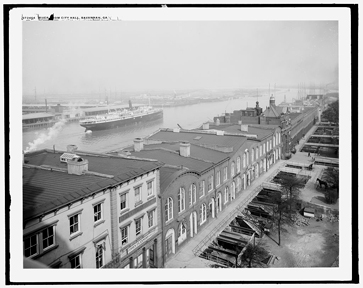
James Edward Oglethorpe
Both the port of Savannah and the colony of Georgia were founded by the English nobleman James Edward Oglethorpe. Leading a contingent of 120 settlers aboard his ship Anne, Oglethorpe crossed the Atlantic Ocean, sailed up the Savannah River, and landed in Savannah in February 1733. The new Georgia colony rapidly expanded inland, and its settlers began to export the new goods and agricultural commodities that they were producing. In 1744, the first dock for ocean-going ships was constructed in Savannah, and within thirty years of the colony’s birth, more than a dozen Savannah warehouses lined the river. Ships carried the products of early Georgia rice plantations to the Old World, and returned with English manufactured goods and Mediterranean wines.
Early 1800s
In the late 18th century, and throughout the early 1800s, the cotton-growing regions of Georgia flourished, and cotton commerce was the economic engine driving many of Georgia’s state-organized road and river improvements. The value of exports through Savannah rose into the tens of millions, and the population steadily climbed as well. By 1855, exports through Savannah had risen to $20.1 million, of which almost 90% was cotton.
Throughout those years, river navigation was improved by the City of Savannah, state-chartered private companies, state legislature funding, and federal funding. Control of harbor navigation and channel projects nationwide was eventually and solidly transferred to the control of the U.S. Congress. Projects and maintenance were administered for Congress by the War Department, through the U.S. Army Corps of Engineers.
Constant navigational issues in the Savannah River were shoaling, sandbars, and the presence of logs and various debris. Also, the dozens of sunken wrecks of scuttled vessels and other obstructions from in the Revolutionary War, the War of 1812, and the Civil War remained as hazards to shipping. In the late 1820s, the U.S. Congress appropriated funds to a plan to clear obstructions in the Savannah River. The plan instituted was generally followed for the next thirty years, as wrecks were removed, sandbars dredged, and jetties constructed. Navigable channels were gradually improved in various locations to widths of 150′-300′ feet, and from depths of 8′-10′ to 13-17′ feet.
Late 1800s
Throughout 1880s and 1890s, federal projects studied gradually deepening the channel to depths of 22′, 26′, and 28′. Dredging was a slow and expensive process. Large amounts of funds were required for the projects, and maintenance dredging was a constant need, as the Savannah River traditionally carried large amounts of outgoing sediment in it’s flow. By the 1920s, the Savannah River had navigable depths of 21′ up to King’s Island (the Savannah River areas upriver of the main downtown area).. Companies began located their manufacturing facilities farther and farther upriver, as the land along the lower reaches of the River were too marshy and unsuitable for construction.
In 1872, The Ocean Steamship Company of Savannah, known as the Savannah Line, was created for passenger and freight service between Savannah, New York, and Boston. The Savannah Line began with six steamships, which were acquired for a total of $600,000. The Ocean Steamship terminal was constructed in Savannah with slip berths and adjacent warehousing. Four railroads—the Central of Georgia, Atlantic Coast Line, Seaboard Air Line, and Southern Railway—had service into the terminal. By 1876, imports and exports through Savannah totaled $70 million.
20th Century
As the twentieth century began, the United States was a growing world power, and gradually became more involved in World War I. Congress authorized the deepening of portions of the Savannah River to 30′. Lower areas of the Savannah River up to the city were dredged to 30′ by the late 1920s and 1930s. Depths in the River portions up to King’s Island were similarly expanded to 26′ depths, and 200′ widths in the 1930s.
At the start of the twentieth century, the boll weevil insect decimated cotton crops across the Southeast, and Georgia’s were not spared. Production and exports of cotton plummeted, and the economy followed suit, as the mix of Savannah’s imports and exports began to change. After undergoing the wrenching changes that come with such economic upheaval, Savannah took a turn for the better when manufacturing operations sprouted along the Savannah River banks. Beginning with the Savannah Sugar Refinery, and following with Union Bag (a kraft paper mill), the port’s river economy began to revitalize. In 1925, the Georgia legislature allowed the Savannah Port Authority to acquire land and operate a terminal.
World War II
During World War II, Savannah’s industries focused on the war effort. Savannahians contributed mightily, as workers at the Southeastern Shipyard in Savannah constructed 88 Liberty Ships. These legendary workhorse ships carried troops, arms, and supplies to U.S. and Allied forces in all theaters of the war. Many of the ships constructed in Savannah were named after Georgia cities and prominent figures in Georgia history. Tragically, four of these ships were sunk by enemy forces.
Georgia Ports Authority
In 1945, the three-person Georgia Ports Authority was created by the State of Georgia. In 1948, the former U.S. Army’s Savannah Quartermaster Depot, a 407-acre tract in Garden City (just outside of Savannah), was purchased by the state for the site of the first GPA terminal. In 1953, the terminal opened with several berths, gantry cranes, and warehouses at the site, which was now named the Garden City Terminal. Five years later, the GPA purchased the Ocean Steamship Terminal from the Central of Georgia Railroad, and began construction of a new cargo terminal.
Through the late 1940s and during the 1950s, the Savannah River channel was improved to 36′ in depth and 500′ in breadth up to the mouth of the River, and 34′ deep and 400′ wide in the inner harbor, up to eight-tenths of a mile above the Seaboard Airline Railway Bridge. Also, turning basins were dredged and improved. The railway bridge, with a center span which could lift 116′ above the river, was the only bridge across in the harbor. As vessels increased in size, the bridge came to be seen as a navigational hazard. Plans for modernization of the bridge were delayed by the onset and duration of World War II, but were effected during the 1950’s. In the Rivers and Harbors Act of 1954, Congress provided for improvements of further reaches of the Savannah River. The channel was deepened to 34′ wide and widened to 400′ to just above the Garden City Terminal. Also, the King’s Island Turning Basin was constructed.
Talmadge Bridge
The Eugene Talmadge Memorial Bridge crosses the Savannah Harbor Navigation Channel approximately 15 miles from the mouth of the Savannah River. Construction began in March, 1953, and the project opened to traffic in September, 1954. The construction cost was approximately $12,500,000 and was paid with state bonds. The original bridge was a cantilever truss bridge with a vertical clearance of 136 feet at high tide and a horizontal clearance of approximately 600 feet.
Four years later, just as the first turning basin project was being completed, recommendations were submitted for widening and deepening it. Concerns had arisen in regards to the increasing number of larger and larger vessels calling the port, and the costly tidal delays that these vessels faced. The recommendations were approved by Congress, and the turning basin expansion work was completed in 1965.
Container Ships and LNG Carriers
Although perhaps difficult at the time to foresee the tremendous changes on the horizon, 1965 was also an important year to Savannah’s maritime community for another reason. That year heralded the arrival of the first containerized cargo handled in the port. A few years later, the GPA was operating the first container crane in the South Atlantic region. In the 1970’s, a Liquid Natural Gas facility was established on Elba Island.
New 185 ft Bridge and 42 ft Channel
The first container ships carried about 2,500 TEUs (20-foot equivalent units). These ships grew in size until the first Post-Panamax ships arrived with beams in excess of 106 feet, too wide for the Panama Canal. Additional container berths were constructed in Garden City to accommodate these ships and the first Talmadge Bridge was replaced with a cable-stayed bridge to provide adequate clearance, or air draft. The new Talmadge Bridge was completed and opened to traffic in March of 1991 with a vertical clearance of 185 feet at high tide and a horizontal clearance of 1,023 feet.
In 1994, the bar channel was increased to 45 foot depth and the channel depth was increased to 42 feet to accommodate larger ships with up to 4,800 TEUs. In the fall of 2001, the LNG river dock and 4 Bcf storage facility on Elba Island was recommissioned by Southern LNG.
Intermodal Operations
The Mason Intermodal Container Transfer Facility started operations in 2001 and increased the efficiency of transferring containers to and from trucks and rail cars. GPA opened Container Berth 8, Garden City, and exceeded 2,000,000 TEU annual transfers in 2006. Container ships with about 6800 TEU’s are able to call based on tidal conditions.
In 2006 the Elba Island LNG Facility opened a two berth off-river dock for LNG carriers and increased storage to 7.3 Bcf. The berths were expanded to handle Q-max vessels in 2009 and work progressed to complete a total of 11.5 Bcf LNG storage capacity.
Post-Panamax
In July 2009, Georgia Ports Garden City Terminal Berths 2-3 and 8-9 were deepened to 48 ft to accept Post-Panamax vessels and larger vessels resulting from the deepening of the Panama Canal, due to be completed in 2014.
Savannah Harbor Expansion Project
USACE approved SHEP with a Record of Decision in November, 2012. Authorization and Financial agreements were established in October, 2014. Dredging started in September 2015.
